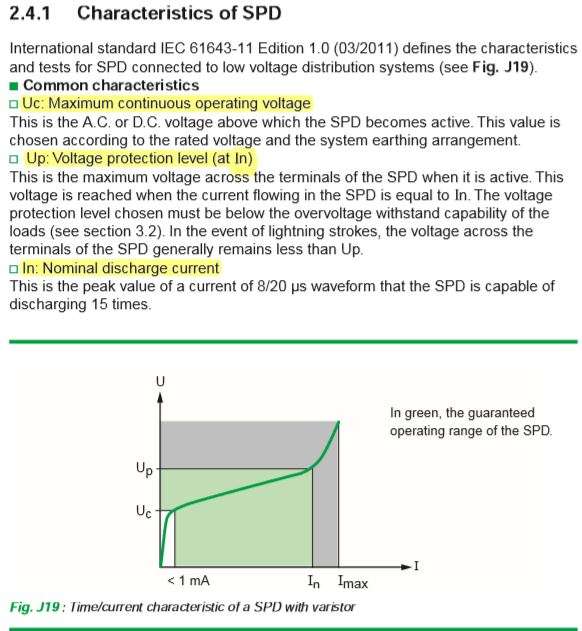- #36
kiki_danc
- 353
- 9
The installer returned asap to put the cable clamp (although I think the term is more like tube protector?).

I noticed the wires running from the top to the circuit breaker is about 1 foot. I think the requirement is it should be 6 inches or the VPR would increase? Need to check computation so can let installer make changes to the orientation and wire length.
Anyway. After some pondering... it seems the lower clamping voltage of 500 volts in the white strip surge protectors is equivalent to the higher clamping voltage of the SPDs of 1200 volts. This is because the former uses UL 1339 3rd edition test vector of 6000 volts but only 0.5 kA while the latter test uses UL 1339 4rd edition 6000 volts and 3 kA.. 6 times more... both test still use the 8/20 µs surge pulse.
https://library.e.abb.com/public/1e3ee76b6b93d21ac1257a0f005711d1/Leaflet%20UL1449_Surge%20Protection%20Devices_1TXH%20000%20106%20L0201.pdf quoting:
"The measured voltage protection level. One of the last changes found in the new UL 1449 3rd Edition, is the modification in the measured voltage protection level. The Measured Limiting Voltage (MLV) is the maximum magnitude of voltage measured at the application of a specific impulse wave shape. When applying a certain surge current on the SPD the measured voltage at the device terminals is the so called “let-through voltage.” In UL 1449 2nd Edition, the let-through voltage was referred to as Suppressed Voltage Rating (SVR) and was calculated with a 0.5 kA surge wave form at 6 kV. The new designation is Voltage Protection Rating (VPR) and is calculated with a 3 kA surge wave form at 6 kV.
The MLV will allow comparison of different types of SPDs with regards to the let-through voltage. However, it is important to
Here is another good reference.
https://ewh.ieee.org/r3/nashville/events/2011/Surge Protection Device Standards - IEEE Meeting.pdf
so the 1200 volts is a new standard.. but won't it damage 220 volts equipments.. let's compute... Rive.. more reference welcomed.. thanks..
I noticed the wires running from the top to the circuit breaker is about 1 foot. I think the requirement is it should be 6 inches or the VPR would increase? Need to check computation so can let installer make changes to the orientation and wire length.
Anyway. After some pondering... it seems the lower clamping voltage of 500 volts in the white strip surge protectors is equivalent to the higher clamping voltage of the SPDs of 1200 volts. This is because the former uses UL 1339 3rd edition test vector of 6000 volts but only 0.5 kA while the latter test uses UL 1339 4rd edition 6000 volts and 3 kA.. 6 times more... both test still use the 8/20 µs surge pulse.
https://library.e.abb.com/public/1e3ee76b6b93d21ac1257a0f005711d1/Leaflet%20UL1449_Surge%20Protection%20Devices_1TXH%20000%20106%20L0201.pdf quoting:
"The measured voltage protection level. One of the last changes found in the new UL 1449 3rd Edition, is the modification in the measured voltage protection level. The Measured Limiting Voltage (MLV) is the maximum magnitude of voltage measured at the application of a specific impulse wave shape. When applying a certain surge current on the SPD the measured voltage at the device terminals is the so called “let-through voltage.” In UL 1449 2nd Edition, the let-through voltage was referred to as Suppressed Voltage Rating (SVR) and was calculated with a 0.5 kA surge wave form at 6 kV. The new designation is Voltage Protection Rating (VPR) and is calculated with a 3 kA surge wave form at 6 kV.
The MLV will allow comparison of different types of SPDs with regards to the let-through voltage. However, it is important to
Here is another good reference.
https://ewh.ieee.org/r3/nashville/events/2011/Surge Protection Device Standards - IEEE Meeting.pdf
so the 1200 volts is a new standard.. but won't it damage 220 volts equipments.. let's compute... Rive.. more reference welcomed.. thanks..




 )
)











